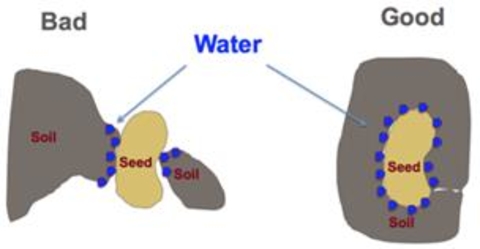Seed-to-soil contact refers to the optimal connection between a seed and the soil, which is essential for successful germination and plant growth. Proper contact ensures that the seed has access to necessary moisture, nutrients, and warmth from the soil. This concept is crucial in agriculture and gardening as it directly impacts germination rates and crop yields.
Why is Seed-to-Soil Contact Important?
Seed-to-soil contact is crucial for successful plant growth and development, primarily because of its role in moisture transfer. Without adequate moisture, seeds will not germinate, and seedlings will struggle to survive. This is particularly important for crops with low drought tolerance, such as carrots, which can perish if not kept moist.
James Shroyer, a professor of agronomy at Kansas State University, emphasizes,
“The importance of good seed-soil contact is as basic as it gets. It allows the seed to readily imbibe moisture and initiate germination and eventually emergence. Without good seed-soil contact, there are air pockets around the seed, delaying germination and resulting in uneven or delayed emergence.”
Plant Growth Effects of Delayed Seed Germination
Delayed germination can significantly impact plant growth:
- Uneven height: Plants may develop at different rates, leading to a non-uniform crop.
- Low germination rate: Seeds may fail to germinate entirely.
- Stunted growth: Poor early development can result in weaker, less vigorous plants.
- Small root system: Insufficient soil contact can limit root expansion, affecting overall plant health.
Signs of Poor Seed-to-Soil Contact
- Uneven height among seedlings
- Low germination rates
- Stunted growth
- Small root systems
If you notice any of these issues, it may indicate a seed-to-soil contact problem.
The primary objective of creating an ideal seedbed is to ensure excellent seed-to-soil contact. This is crucial because most forage seeds need to absorb more than their own weight in water to germinate uniformly.
Soil particles retain the moisture necessary for germination. The greater the contact between soil particles and the seed, the faster the seed can absorb water and begin the germination process.

The Importance of Proper Seed-to-Soil Contact. The seed on the right, due to better soil contact, will absorb the necessary 125% of its weight in water (indicated in blue) more quickly than the seed on the left.
How to Improve Seed-to-Soil Contact
- Proper Soil Preparation: Ensure the soil is well-tilled and free of clumps to create a fine, firm seedbed.
- Using Land Rollers: Tools like land rollers can press seeds firmly into the soil, enhancing moisture transfer and contact. Mandako’s land rollers are effective in achieving this.
- Adjusting Planting Techniques: Use precision seed drills to plant seeds at the correct depth and ensure good soil coverage.
By improving seed-to-soil contact, you can promote better germination, more uniform plant growth, and healthier crops overall.
